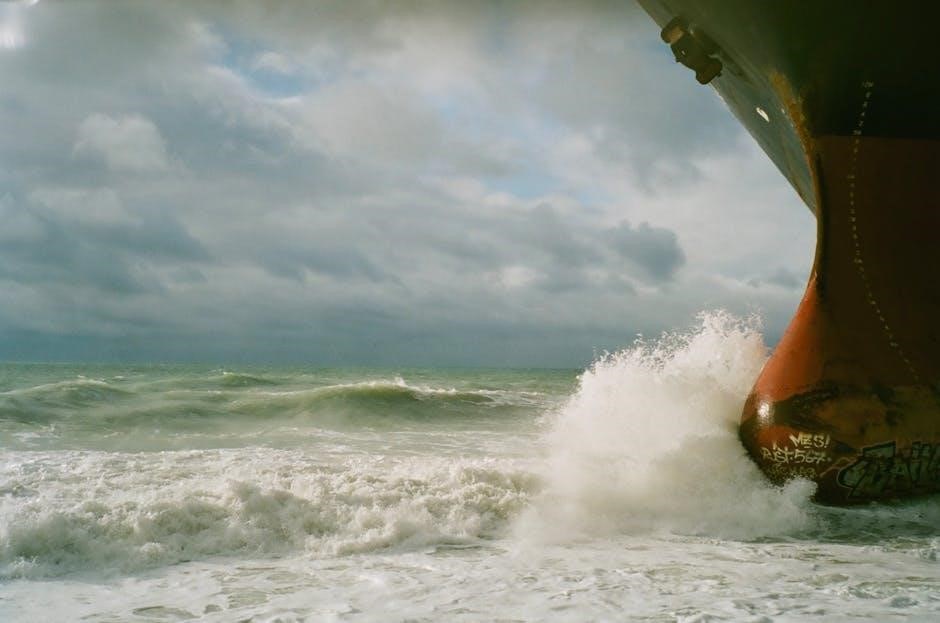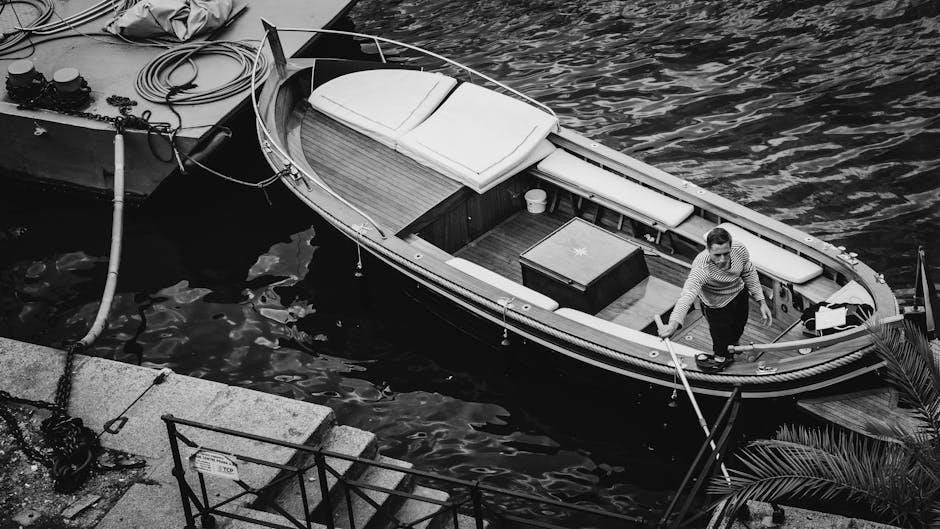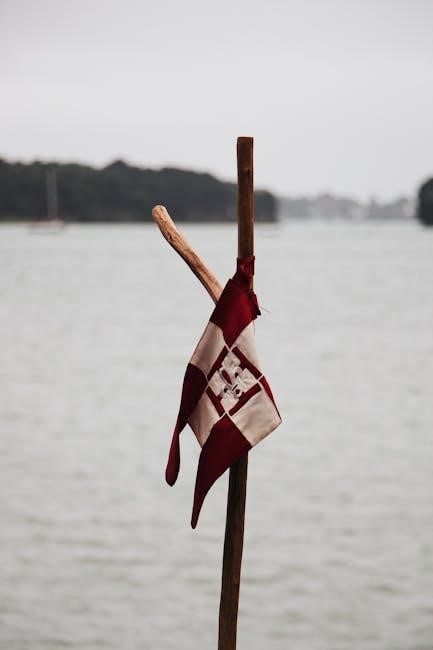
manual power pole for boat
Manual power poles offer a silent, portable, and cost-effective solution for shallow water anchoring, providing anglers and boaters with precise control and minimal environmental impact, made with durable materials ensuring reliability in various conditions.
Overview of Shallow Water Anchoring Systems
Shallow water anchoring systems are designed to secure boats in water depths typically less than 10 feet, providing stability without damaging the environment. These systems are ideal for fishing, kayaking, or resting in calm waters, offering silent deployment and minimal ecological impact.
Manual power poles, a popular choice, use durable materials like fiberglass or aluminum to anchor the boat quietly and effectively. They are lightweight, portable, and suitable for various boat sizes, making them a preferred option for anglers and boaters seeking precise control in shallow conditions.
Importance of Manual Power Poles in Fishing and Boating

Manual power poles are essential for anglers and boaters, offering silent deployment and precise positioning in shallow waters. They minimize disturbance to fish and the environment, making them ideal for fishing. Their portability and ease of use also enhance convenience, while their cost-effectiveness provides a practical solution for securing boats in various conditions without the need for complex systems.
These poles are particularly beneficial for small boats and shallow water fishing, ensuring stability and control. Their durability and lightweight design make them a reliable choice for boaters seeking efficient anchoring solutions that combine functionality with affordability, catering to both recreational and professional fishing needs effectively.
Benefits of Using a Manual Power Pole
Manual power poles provide silent, portable, and cost-effective anchoring solutions, ideal for shallow waters. They offer ease of use without complex systems, making them an eco-friendly choice for anglers and boaters.
Silent and Non-Invasive Anchoring
Manual power poles deliver ultra-quiet anchoring, minimizing noise that might scare fish. Their non-invasive design ensures minimal disturbance to the environment, making them ideal for anglers seeking stealth and precision in shallow waters without disrupting marine ecosystems or nearby wildlife.
Cost-Effective Alternative to Electric or Hydraulic Systems
Manual power poles are a budget-friendly option compared to electric or hydraulic systems, offering significant cost savings without compromising performance. They eliminate the need for expensive motors or complex installations, making them an economical choice for anglers and boaters seeking reliable shallow water anchoring solutions while minimizing long-term maintenance and operational expenses.
Portability and Ease of Use
Manual power poles are lightweight and compact, making them easy to transport and install on various boats. Their simple, user-friendly design allows for quick deployment in shallow waters, ensuring minimal effort and maximum efficiency. This portability and ease of use make them an ideal choice for anglers and boaters seeking convenience without compromising anchoring performance.

Types of Manual Power Poles
Manual power poles are available in fiberglass composite, aluminum, and adjustable telescoping designs, offering durability, portability, and easy adjustability to suit various boating needs effectively.
Fiberglass Composite Poles
Fiberglass composite poles are lightweight, durable, and resistant to corrosion, making them ideal for shallow water anchoring. Their smooth, non-abrasive surface ensures easy handling, while the tapered spike tip provides a secure hold in various bottom conditions. These poles are easy to deploy manually and maintain, offering a reliable solution for anglers seeking a silent and efficient anchoring experience in shallow waters.
Aluminum and Other Durable Materials
Aluminum and other durable materials are widely used in manual power poles due to their strength, lightweight design, and corrosion resistance. These poles are ideal for shallow water anchoring, offering excellent durability and reliability. Their robust construction ensures they can withstand harsh marine environments, making them a practical choice for anglers and boaters seeking long-lasting performance and minimal maintenance.
Adjustable and Telescoping Designs
Adjustable and telescoping manual power poles provide versatility for various shallow water conditions. These designs allow users to extend or retract the pole as needed, ensuring optimal anchoring in different depths. Their compact and foldable nature enhances portability, making them easy to transport and store. This adaptability ensures a secure hold while accommodating different boat sizes and fishing scenarios effectively.

Installation and Setup
Mounting brackets and hardware are essential for secure installation. Follow a step-by-step guide for easy setup. Compatible with various boat types, ensuring stability and convenience.
Mounting Brackets and Hardware
Sturdy mounting brackets and durable hardware are crucial for securing manual power poles. Made from corrosion-resistant materials like aluminum or stainless steel, they ensure long-lasting performance in marine environments. These components are designed to withstand harsh conditions while providing a stable base for the pole, ensuring reliable anchoring in shallow waters.
Step-by-Step Installation Guide
Begin by attaching the mounting brackets to your boat’s transom or deck using stainless steel hardware. Align the pole securely, ensuring it fits snugly into the brackets. Tighten all bolts firmly to prevent movement. Finally, test the pole’s deployment and adjustment to ensure smooth operation and stability while anchoring in shallow waters.
Compatibility with Different Boat Types
Manual power poles are compatible with various boat types, including bass boats, flats boats, bay boats, and smaller vessels like jon boats and kayaks. They are ideal for boats under 24 feet and can be adapted to larger boats depending on weight and size. Universal mounting systems ensure easy installation across different boat designs, making them versatile for a wide range of boating needs.

Maintenance and Care
Regular cleaning, inspection, and proper storage are essential to maintain the durability of manual power poles. Lubricate moving parts and protect against rust for optimal performance and longevity.
Cleaning and Inspecting the Pole
Regularly clean the pole with a soft cloth and mild detergent to remove dirt and grime. Inspect for dents, corrosion, or wear. Check the mounting hardware for tightness and lubricate moving parts to ensure smooth operation. Address any damage promptly to prevent rust and maintain the pole’s effectiveness in shallow water anchoring.
Storage Tips for Longevity
Store the manual power pole in a dry, protected area to prevent corrosion. Clean and dry the pole thoroughly before storage to avoid rust. Use a protective cover or case to shield it from dust and UV exposure. Avoid extreme temperatures and humidity to maintain material integrity and ensure optimal performance when reused.
Troubleshooting Common Issues
Common issues include the pole not securing properly or difficulty in deployment. Check for debris, ensure the anchor spike is clean, and verify bracket alignment. If the pole doesn’t hold, try adjusting the angle or relocating to a firmer bottom. Regular maintenance, such as cleaning and lubricating moving parts, can prevent many problems and extend the pole’s lifespan.

Choosing the Right Manual Power Pole
Selecting the ideal manual power pole involves considering boat size, weight, and fishing environment. Opt for durable materials like fiberglass or aluminum, ensuring the pole’s length and strength match your vessel’s needs for reliable performance in shallow waters.
Considering Boat Size and Weight
When selecting a manual power pole, ensure it matches your boat’s size and weight. For smaller boats like jon boats or skiffs, shorter poles (8-10 feet) suffice. Larger vessels, such as bass or flats boats, require longer, sturdier poles (10-12 feet) for stability. Choose materials like fiberglass or aluminum, balancing durability and portability for your specific boating needs in shallow waters.
Selecting the Right Length and Material
Selecting the right length and material for your manual power pole ensures optimal performance. Fiberglass poles are lightweight and durable, ideal for shallow waters, while aluminum offers strength for heavier boats. Choose lengths between 8-12 feet based on water depth and boat type. Ensure the material aligns with your boating needs for portability, ease of use, and reliability in various conditions.
Brand and Quality Considerations
When selecting a manual power pole, consider reputable brands like Power-Pole, Stayput Anchor, and Lewmar Vector, known for durability and performance. Look for corrosion-resistant materials, sturdy construction, and features like silent deployment. Ensure the brand offers reliable customer support and warranties. High-quality poles provide long-term reliability, ensuring your boating experiences remain hassle-free and enjoyable in shallow waters.
Popular Brands and Models
Leading brands like Power-Pole, Stayput Anchor, and Lewmar Vector offer top-tier manual power poles. Models such as Power-Pole Blades, Stayput Anchor Systems, and Lewmar Vector Manual Shallow Water Anchor are highly regarded for their performance and durability in shallow water conditions.
Power-Pole Shallow Water Anchors
Power-Pole Shallow Water Anchors are renowned for their silent deployment and secure hold, offering unmatched versatility for anglers and boaters. With over 20 years of innovation, Power-Pole systems provide fast, reliable anchoring in shallow waters. Their products, like the MICRO Anchor, cater to smaller craft while larger models support skiffs, bass boats, and bay boats, ensuring precise control and durability.
Lewmar Vector Manual Shallow Water Anchor
The Lewmar Vector Manual Shallow Water Anchor offers anglers precise control with a hands-on design, operating swiftly and silently. Constructed from corrosion-resistant, powder-coated aluminum, it features a quick deployment mechanism and a secured penetrating fiberglass spike. Ideal for boats up to 22 feet or 3,000 pounds, it provides reliable stability and low-maintenance performance, perfect for shallow water anchoring needs.
Stayput Anchor Systems
Stayput Anchor Systems provide a faster, quieter, and more affordable shallow water anchoring solution. Designed for boats under 24 feet, they offer sleek designs and easy installation. As pioneers with over a decade of experience, Stayput Systems cater to small skiffs, flats boats, and similar craft, ensuring secure and hassle-free anchoring in shallow waters.
Comparison with Automatic Power Poles

Manual power poles are cost-effective and portable, while automatic systems offer faster deployment and remote control, though at a higher cost and complexity, catering to different user preferences.
Advantages of Manual Systems
Manual power poles offer simplicity, reliability, and ease of use without reliance on electricity or hydraulics. They provide a cost-effective solution, requiring less maintenance and offering silent operation, making them ideal for anglers seeking a straightforward, eco-friendly anchoring method in shallow waters.
Limitations and Trade-offs
Manual power poles require physical effort for deployment and retrieval, limiting their use in strong currents or deep waters. They may not hold as securely in soft or muddy bottoms compared to automatic systems. Additionally, they are less efficient for larger boats and lack the convenience of remote operation, making them less suitable for demanding conditions or heavy-duty applications.
Cost and Maintenance Differences
Manual power poles are generally more affordable than automatic systems, with lower upfront costs and simpler maintenance. However, they require more physical effort and may need occasional part replacements. Regular cleaning and inspections are essential to ensure longevity, balancing the initial savings with potential long-term maintenance needs.
Safety Tips and Best Practices
Always ensure proper deployment, secure the boat firmly in shallow waters, and have emergency retrieval methods ready to handle unexpected situations safely and efficiently.
Proper Deployment Techniques
Approach shallow areas slowly, ensuring the pole is vertical and firmly planted in the bottom. Avoid forceful insertion to prevent damage. Test the hold by gently pulling the boat backward. Always maintain control during deployment to secure the vessel safely and effectively in shallow waters, minimizing movement and potential environmental disturbance.
Securing the Boat in Shallow Waters
Ensure the manual power pole is fully embedded in the seabed for maximum stability. Adjust the angle to minimize drift and maintain balance. Use the pole in conjunction with other stabilizers if needed. Regularly check the pole’s hold to ensure the boat remains secure, especially in changing water conditions or currents, for a safe and steady anchoring experience.
Emergency Retrieval Methods
In case the manual power pole gets stuck, gently rock the boat to loosen the pole. If this fails, carefully pull the rope to dislodge it. Use a retrieval tool or apply controlled force to avoid damage. Ensure the pole is fully retracted before moving the boat, preventing further complications in shallow waters.
Legal and Environmental Considerations
Ensure compliance with local anchoring regulations to protect marine ecosystems. Manual power poles minimize environmental disruption, promoting responsible boating practices in sensitive shallow water habitats.
Regulations for Shallow Water Anchoring
Always check local regulations for shallow water anchoring to avoid fines and protect marine ecosystems. Manual power poles must comply with restrictions in protected areas, such as seagrass beds or coral reefs. Ensure your system does not damage the environment or obstruct navigation channels. Permits may be required in certain regions, so stay informed and adhere to all legal guidelines.
Environmental Impact of Anchoring
Manual power poles minimize environmental impact by avoiding heavy equipment that disrupts habitats. Their design reduces sediment disturbance and prevents damage to seagrass beds and coral reefs. Responsible anchoring practices with manual poles help preserve marine ecosystems, promoting sustainable boating and protecting vulnerable underwater environments for future generations.
Responsible Boating Practices
Responsible boating involves minimizing environmental impact and adhering to ethical practices. Using manual power poles encourages anchoring in non-sensitive areas, reducing habitat disruption. Always follow local regulations, avoid anchoring in protected zones, and ensure proper disposal of waste. By adopting these practices, boaters help preserve marine ecosystems and promote sustainable waterway use for future generations.

Future Trends in Manual Power Poles
Future trends include innovative materials, integration with smart technologies, and eco-friendly designs, enhancing portability and efficiency while maintaining affordability for anglers and boaters.
Innovations in Materials and Design
Advancements in materials include lightweight yet durable options like high-strength fiberglass-composite poles and corrosion-resistant aluminum. Designs now feature telescoping and adjustable lengths, improving versatility for various boat sizes and water conditions. These innovations enhance portability, ease of use, and reliability, making manual power poles more efficient and adaptable for modern anglers and boaters.
Integration with Other Boating Technologies
Manual power poles are increasingly being integrated with GPS, trolling motors, and fish finders for enhanced control. This seamless connectivity allows for precise positioning and automated adjustments, improving overall boating efficiency. Compatibility with advanced marine electronics ensures a modern, user-friendly experience, making manual power poles a versatile component of integrated boat systems for anglers and recreational users alike.
Market Demand and Consumer Preferences
Manual power poles are gaining popularity among anglers and boaters seeking silent, portable, and cost-effective anchoring solutions. The demand for lightweight, durable designs has surged, with brands like Power-Pole and Stayput Anchor leading the market. Consumers increasingly prefer systems compatible with smaller boats and modern marine electronics, driving innovation in materials and functionality to meet diverse boating needs.
Manual power poles are an effective, silent, and portable solution for shallow water anchoring, offering precise control and minimal environmental impact, making them ideal for anglers and boaters.
Final Thoughts on Manual Power Poles
Manual power poles are a practical, silent, and cost-effective solution for shallow water anchoring, offering boaters and anglers precise control and minimal environmental impact. Durable materials ensure longevity, while their portability and ease of use make them ideal for various boat types. They provide a reliable alternative to electric systems, catering to those seeking simplicity and efficiency in their fishing or boating experiences.
Recommendations for Boat Owners
- Choose a manual power pole that matches your boat’s size and weight for optimal performance.
- Consider durable materials like fiberglass or aluminum for longevity in harsh marine environments.
- Opt for adjustable or telescoping designs for versatility in different water depths.
- Explore reputable brands like Power-Pole or Stayput for reliable options.
- Regularly inspect and maintain your pole to ensure smooth operation and extend its lifespan.

Additional Resources
Access manufacturer manuals, online forums, and professional installation services for detailed guidance, troubleshooting, and expert advice on manual power poles to optimize performance.
Manufacturer Guides and Manuals
Manufacturer guides and manuals provide detailed instructions for installing, operating, and maintaining manual power poles. Brands like Power-Pole and Lewmar offer comprehensive resources, including troubleshooting tips and warranty information. These documents are available on official websites, ensuring users can maximize their product’s performance and longevity while adhering to safety standards.
Online Communities and Forums
Online communities and forums offer valuable resources for boat owners, sharing experiences and tips on manual power poles. Platforms like TBNation.net and specialized fishing forums provide troubleshooting advice, product recommendations, and installation guidance. These communities foster collaboration, helping users optimize their anchoring systems and address common challenges effectively.
Professional Installation Services
Professional installation services ensure your manual power pole is correctly fitted, optimizing performance and longevity. Certified technicians provide expert setup, addressing specific boat requirements. Many manufacturers, like Power-Pole and Stayput Anchor, offer installation support, ensuring reliability and safety. These services are ideal for boat owners seeking a hassle-free, precise setup tailored to their vessel’s needs.